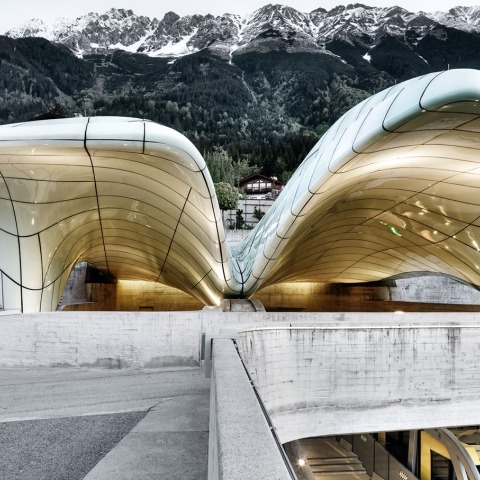The Hungerbur funicular (Hungerburgbahn) is part of Innsbruck's Nordpark Cable Railway (Nordkettenbahnen) and begins at the Congress underground station in the centre of the city. Trains stop at Lowenhaus Station before crossing the bridge over the River Inn, then climbing to Alpenzoo Station and on to Hungerburg where passengers can continue their journey on the Seegrube and Hafelekar cable cars up to its summit at 2,300m.
Shortlisted for the 2008 Stirling Prize by the Royal Institute of British Architects, the design of each station adapts to its own unique context, topography, altitude, and passenger circulation, with roofs that echo natural ice formations, like glaciers of frozen mountain streams.
Each station's lightweight roof structure "floats" above a concrete plinth, creating an artificial landscape that describes the passenger circulation within. When completed in 2007, the stations were the world's largest structures using double-curved glass in construction.
Description of project by Zaha Hadid Architets (ZHA).
The project contains the design of four stations along the cable railway tracks leading up to Innsbruck’s northern chain of mountains. Adaptation to the specific site conditions in various altitudes while articulating a coherent overall architecturalnlanguage is critical to this design approach.
Two contrasting elements “Shell & Shadow”ngenerate each station’s spatial quality. A lightweight organic roof structure fl oats on top of a concrete plinth. The artificial landscape functions as a relief in which various movements and circulations are inscribed. Looking at the Roof Shell’s fluid shapes and soft contours, one might be reminded on natural phenomena such as glacier movements.
New production methods like CNC milling and thermoforming guarantee a very precise and automatic translation of the computer generated design into the built structure. The resulting aesthetics might be reminiscent of streamlined Industrial Design pieces (Car Bodies, Aeroplane Wings, Yachts etc.). Each station has its context, its topography, its altitude, its movements. The track’s inclination and ratios are dominant technical parameters. A high degree of flexibility enables the shell structures to adjust to these various parameters while still being part of the same formal family. The concept of lightness is explored. Large cantilevers and small touch down areas underline a floating appearance of the shells.








































